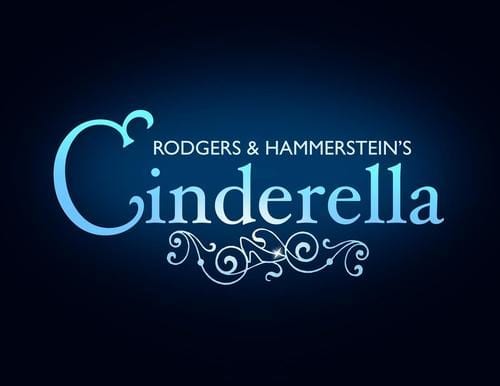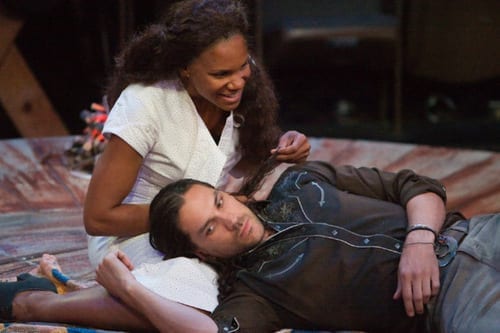LEHI — The story of Cinderella is one that most are familiar with. A poor orphaned girl forced to live under the watchful and spiteful eye of her evil stepmother and two ugly stepsisters until a ball is announced by the royal family, and she has a magical night, ending in the abandoning of one of her glass slippers. The smitten prince scours the land looking for the charming young maiden who fits this shoe, unknowingly searching for this poor girl who spends her time in the cinders. A story of magic, love, and justice is one to be enjoyed. Pioneer Alumni Repertory Company (PARC), under Mason Holmstead‘s direction, tried to give a modern take on the classic by Rodgers and Hammerstein, unfortunately losing a touch of magic along the way.
Cinderella was played by Ashley Coombs, and was pleasant. Coombs had a good approach to the soft character of a mousy young lady, and captivated attention in several moments through the show, especially during “A Lovely Night” and “Do I Love You Because You’re Beautiful?” At both of these points during the show, I felt the rush of magic meant to accompany this show, and thanks to Coombs’s work in the title role. Several pivotal moments that lacked the same feeling were during “My Own Little Corner” and “Impossible/Possible” where it seemed the vocals were the center of focus, and there was less time and energy put into blocking or characterization. While the vocals were correct, the scenes still fell flat due to that lack of attention.
Christian Riboldi played the prince of the story, Christopher. The performance Riboldi gave was genuine and moving when in connection with another character like the royal steward, his parents, or Cinderella, but lacked development while alone. The movements of the character were definite and concise, but lacked understanding of why the decisions were being made. Riboldi often put so much attention into not turning his back on the audience that he would find himself walking backwards to find his mark, while he stood in relaxed poses and walked with a bounce in his step, every movement has a tense feeling behind it, which gave an unnatural feel to the character.
The character of the royal steward, (played by Cade Peirce) commanded attention, and Perice seemed relaxed and developed in his acting. When singing his solo, “The Prince is Giving a Ball,” his character flourished and had fun, while still maintaining a professional demeanor of a herald. His friendship with Christopher seemed real and innocent, and the different relationships with other characters were as varied as they were entertaining. The portrayal went beyond that of time when the spotlight was on him, and he could often be found in character when other people were the focus, which was not always the case in this cast.
The stepsisters in this version of the classic tale are often steal the show, as they have strong personalities written into the script. In this production, the stepsisters were played very large in character, and an interesting decision was made to cast Tanner Perelle as Grace. This casting decision has potential, but requires full commitment from the man chosen to play a woman on stage. In this case the commitment to the idea that Perelle was a woman was lacking. Throughout the production, there were several blatant references in both word and action that this sister was not in fact a sister, including jokes about the mannish features and slapstick kicks to the groin that would not have been included in the blocking if he was a woman. This casting choice could have been fulfilled and entertaining if there was no distinction that Perelle was a man in a dress, but seemed forced and pulling laughs not written into Tom Briggs‘s script.
Alec Powell portrayed the king in this production, and did so with confidence and a clear voice. His moments with his wife and son were loving and tender, while keeping up the idea that he was still the King and would use his power to help his family, if necessary.
The technical aspects of this production were varied in their effects. The microphones always seemed to pick up the right amount of sound from those needing it, but the minus tracks for the musical numbers was consistently late, and accompanied by moments of awkward silence waiting for music to either start or catch up to the actors who were several seconds ahead of the tracks. The costuming for this show was complex in some areas and simple in others. The modern setting made it simple to costume casual scenes by asking actors to provide their own attire, but the costumer, Haley Florence, had her hands full with the royal ball scene, and pulled it off well with beautiful gowns for each woman and a tuxedo fitting of each of the gentlemen perfectly.
The ensemble was large and talented, but often would overpower the lead characters. The distraction did not come from the movements, but from the volume of the other people on stage. Such occasions include during the opening scene in the town center and at the royal ball where several conversations and some lyric was lost in the dull roar of ensemble chattering, and the moment was hard to pull back into.
This production of Cinderella had some wonderful visions for the modern view of the classic story, and the set (designed by Isaac Fox) was impressive with multiple levels for effect. Unfortunately for all of the vision of great things that could have been pulled off in this performance, the negative aspects and uncommitted parts were distracting and effectively wiped out the magic in this magical fairy tale.






